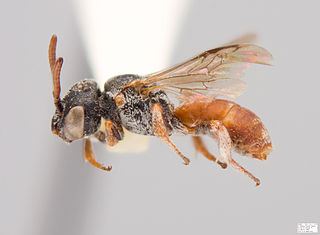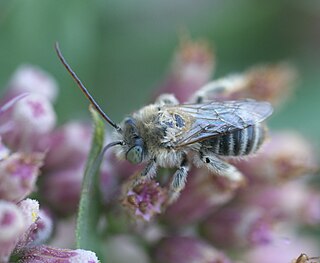
Bees are winged insects closely related to wasps and ants, known for their roles in pollination and, in the case of the best-known bee species, the western honey bee, for producing honey. Bees are a monophyletic lineage within the superfamily Apoidea. They are currently considered a clade, called Anthophila. There are over 20,000 known species of bees in seven recognized biological families. Some species – including honey bees, bumblebees, and stingless bees – live socially in colonies while most species (>90%) – including mason bees, carpenter bees, leafcutter bees, and sweat bees – are solitary.

A bumblebee is any of over 250 species in the genus Bombus, part of Apidae, one of the bee families. This genus is the only extant group in the tribe Bombini, though a few extinct related genera are known from fossils. They are found primarily in higher altitudes or latitudes in the Northern Hemisphere, although they are also found in South America, where a few lowland tropical species have been identified. European bumblebees have also been introduced to New Zealand and Tasmania. Female bumblebees can sting repeatedly, but generally ignore humans and other animals.

Apidae is the largest family within the superfamily Apoidea, containing at least 5700 species of bees. The family includes some of the most commonly seen bees, including bumblebees and honey bees, but also includes stingless bees, carpenter bees, orchid bees, cuckoo bees, and a number of other less widely known groups. Many are valuable pollinators in natural habitats and for agricultural crops.

Bombus terrestris, the buff-tailed bumblebee or large earth bumblebee, is one of the most numerous bumblebee species in Europe. It is one of the main species used in greenhouse pollination, and so can be found in many countries and areas where it is not native, such as Tasmania. Moreover, it is a eusocial insect with an overlap of generations, a division of labour, and cooperative brood care. The queen is monandrous which means she mates with only one male. B. terrestris workers learn flower colours and forage efficiently.

Tetragonula carbonaria is a stingless bee, endemic to the north-east coast of Australia. Its common name is sugarbag bee. They are also occasionally referred to as bush bees. The bee is known to pollinate orchid species, such as Dendrobium lichenastrum, D. toressae, and D. speciosum. It has been identified as an insect that collects pollen from the cycad Cycas media. They are also known for their small body size, reduced wing venation, and highly developed social structure comparable to honey bees.
Heinrich Friedrich August Karl Ludwig Friese was a German biologist and entomologist, a specialist of bees (melittologist). Between 1883 and 1939, he described 1,989 new species and 564 new varieties or subspecies of insects, 99% of which were bees.

Tetragonisca angustula is a small eusocial stingless bee found in México, Central and South America. It is known by a variety of names in different regions. A subspecies, Tetragonisca angustula fiebrigi, occupies different areas in South America and has a slightly different coloration.

Melipona capixaba, commonly known as uruçu negra in Brazil, is a species of eusocial stingless bees of the order Hymenoptera. It is endemic to the mountainous region of the State of Espirito Santo, Brazil. Since 2003, it has been included on the list of threatened species produced by the Brazilian Ministry of the Environment, and is the only eusocial insect on this list.

Bombus trophonius is an extinct species of bumble bee known from a Miocene fossil found in Europe. It belongs to the Bombus subgenus Cullumanobombus and is considered most similar to the living species Bombus rufocinctus of North America.
Nomada verecunda is a species in the family Apidae, in the order Hymenoptera . Nomada verecunda is found in North America.

Townsendiella rufiventris is a cuckoo bee species in the family Apidae. It is found in the United States and Mexico.
Triepeolus grandis is a species of cuckoo bees in the family Apidae. It is found in the United States and Mexico.

Triepeolus is a genus of cuckoo bees in the family Apidae. There are at least 140 described species in Triepeolus. The majority of species whose life history is known are kleptoparasitic in the nests of bees in the tribe Eucerini, especially the genera Melissodes and Svastra.

Bombus vandykei, the Van Dyke's bumble bee, is a species of bumble bees in the family Apidae. It is found in North America.

Neolarrini is a tribe of cuckoo bees in the family Apidae. There are 5 genera and about 40 described species in Neolarrini, which includes the genera and species formerly included in the deprecated tribes Biastini and Townsendiellini.
Triepeolus rufithorax is a species of cuckoo bee in the family Apidae. It is found in North America.
Habropoda pallida, known generally as the pallid habropoda or white-faced bee, is a species of anthophorine bee in the family Apidae. It is found in Central America and North America.

Melissodes is a genus of long-horned bees in the family Apidae. There are 129 described species in Melissodes.
Biastes mojavensis is a species of cuckoo bee in the family Apidae, in the subgenus Neopasites. It is found in North America.
Brachymelecta californica is a species of cuckoo bee in the family Apidae, found in Central America and North America.












